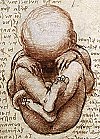Developmental stage theories
| Part of a series on |
| Human growth and development |
|---|
 |
| Stages |
| Biological milestones |
| Development and psychology |
In
There are several different views about psychological and physical development and how they proceed throughout the life span. The two main psychological developmental theories include continuous and discontinuous development.[2] In addition to individual differences in development, developmental psychologists generally agree that development occurs in an orderly way and in different areas simultaneously.[3][page needed]
Stage theories
The development of the human mind is complex and a debated subject, and may take place in a continuous or discontinuous fashion.[4] Continuous development, like the height of a child, is measurable and quantitative, while discontinuous development is qualitative, like hair or skin color, where those traits fall only under a few specific phenotypes.[5] Continuous development involves gradual and ongoing changes throughout the life span, with behavior in the earlier stages of development providing the basis of skills and abilities required for the next stages.[6] On the other hand, discontinuous development involves distinct and separate stages, with different kinds of behavior occurring in each stage.[3][page needed]
Stage theories of development rest on the assumption that development is a discontinuous process involving distinct stages which are characterized by qualitative differences in behavior. They also assume that the structure of the stage is not variable according to each individual; however the time of each stage may vary individually.[1] While some theories focus primarily on the healthy development of children, others propose stages that are characterized by a maturity rarely reached before old age.
Ego-psychology
The psychosexual stage theory created by Sigmund Freud (b.1856) consists of five distinct stages of Psychosexual development that individuals will pass through for the duration of their lifespan. Four of these stages stretch from birth through puberty and the final stage continues throughout the remainder of life.[7] Erik Erikson (b.1902) developed a psychosocial developmental theory, which was both influenced and built upon by Freud, which includes four childhood and four adult stages of life that capture the essence of personality during each period of development.[8] Each of Erikson's stages include both a positive and negative influences that can go on to be seen later in an individual's life. His theory includes the influence of biological factors on development.[9] Jane Loevinger (b.1918) built on the work of Erikson in her description of stages of ego development.
Individuation and attachment in ego-psychology
Cognitive and moral development
Cognitive development
Piaget's cognitive development theory
Jean Piaget's cognitive developmental theory describes four major stages from birth through puberty, the last of which starts at 12 years and has no terminating age:[11] Sensorimotor: (birth to 2 years), Preoperations: (2 to 7 years), Concrete operations: (7 to 11 years), and Formal Operations: (from 12 years). Each stage has at least two substages, usually called early and fully. Piaget's theory is a structural stage theory, which implies that:
- Each stage is qualitatively different; it is a change in nature, not just quantity;
- Each stage lays the foundation for the next;
- Everyone goes through the stages in the same order.
Neo-Piagetian theories
Neo-Piagetian theories criticize and build on Piaget's work. Juan Pascaual-Leone was the first to propose a neo-Piagetian stage theory. Since that time several neo-Piagetian theories of cognitive development have been proposed.[12] These include the theories of Robbie Case, Grame Halford, Andreas Demetriou and Kurt W. Fischer. The theory of Michael Commons' model of hierarchical complexity is also relevant. The description of stages in these theories is more elaborate and focuses on underlying mechanisms of information processing rather than on reasoning as such. In fact, development in information processing capacity is invoked to explain the development of reasoning. More stages are described (as many as 15 stages), with 4 being added beyond the stage of Formal operations. Most stage sequences map onto one another. Post-Piagetian stages are free of content and context and are therefore very general.
Learning and education
Maria Montessori (b.1871) described a number of stages in her educational philosophy. Albert Bandura (b.1925), in his social learning theory, emphasizes the child's experiential learning from the environment.[14]
Spirituality and consultancy
Inspired by Theosophy, Rudolf Steiner (b.1861) had developed a stage theory based on seven-year life phases. Three childhood phases (conception to 21 years) are followed by three stages of development of the ego (21–42 years), concluding with three stages of spiritual development (42-63). The theory is applied in Waldorf education[15]
Other theories
Lev Vygotsky (b.1896) developed several theories, particularly zone of proximal development. Other theories are not exactly developmental stage theories, but do incorporate a hierarchy of psychological factors and elements. Abraham Maslow (b.1908) described a hierarchy of needs.[16] James Marcia (b.1937) developed a theory of identity achievement and identity status.
References
- ^ OCLC 59279973.
- ISBN 9781315517933.
- ^ OCLC 224074696.
- ^ "What Is Lifespan Development? | Introduction to Psychology". courses.lumenlearning.com. Retrieved 2021-03-18.
- ISBN 978-1-317-34322-6.
- ^ "Themes and Theories of Child Development". highered.mheducation.com. Retrieved 2021-03-06.
- ^ "Freud and the Psychodynamic Perspective | Introduction to Psychology". courses.lumenlearning.com. Retrieved 2021-03-16.
- ISBN 978-0-13-441969-5.
- PMID 28124459.
- OCLC 51799325.
- ^ "Cognitive Development | Encyclopedia of Special Education: A Reference for the Education of Children, Adolescents, and Adults with Disabilities and Other Exceptional Individuals - Credo Reference". search.credoreference.com. Retrieved 2021-03-16.
- ^ Demetriou, A. (1998). Cognitive development. In A. Demetriou, W. Doise, K. F. M. van Lieshout (Eds.), Life-span developmental psychology, pp. 179-269. London: Wiley.
- ISBN 0-521-32565-X.
- OCLC 898963514.
- ISBN 1-85584-056-1.
- from the original on 2017-09-14. Retrieved 2007-03-13 – via psychclassics.yorku.ca.
